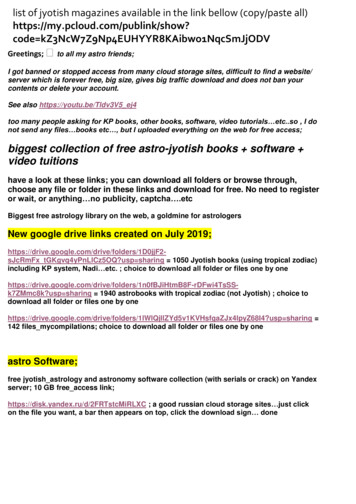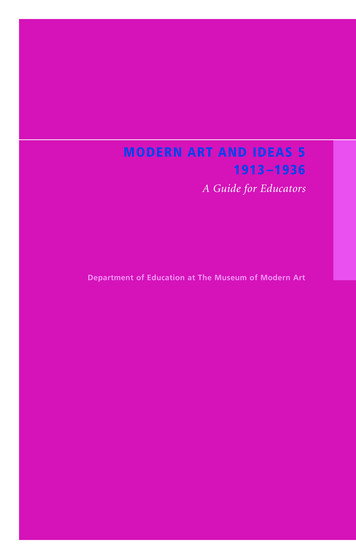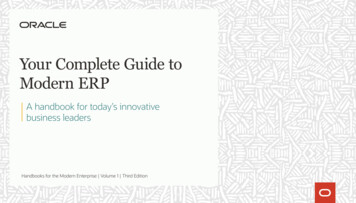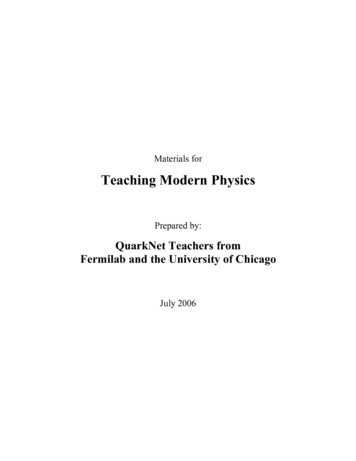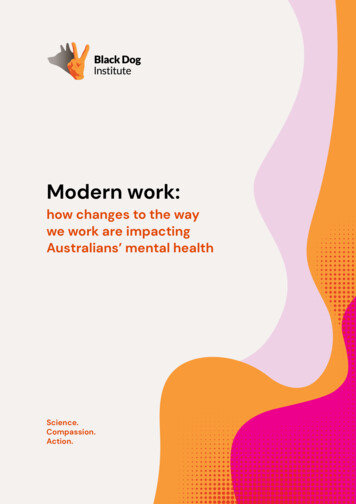
Transcription
Modern work:how changes to the waywe work are impactingAustralians’ mental healthScience.Compassion.Action.
AcknowledgementsIn addition to the authors listed in each section, we wish to thank the followingfor their involvement or input to this white paper:Black Dog Institute: Dr Taylor Braund, Kate Dennis, Emma Elder, Nyree Gale,Nicole Scott, Stacey Vervoot, Kathryn Woodcock, and Laura WhiteExternal contributors: Amelia Bitsis (Business Council of Australia), Erica Crome(National Mental Health Commission), Louise Denver (Denver-Owens & Associates),Liam O’Brien (Australian Council of Trade Unions), and Shannon Threlfall-Clarke(Australian Council of Trade Unions)Lived experience: Special thanks to community representatives and advisorsCaroline Bentley, Kellie Gilbert and Sam Fewings who generously shared theirlived experience.Those listed provided input, however they were not asked to endorse the report’sconclusions or recommendations, nor did they all see the final draft of the reportbefore its release.Design: Cheryl Wong (KU EN Studios)Black Dog Institute.Modern work: how changes to the way we work are impacting Australians’ mental healthWhite Paper. October 2021. Sydney, AU: Black Dog Institute
ContentsExecutive summaryiSection 1.What is modern work?1.1Section 2.Has work in Australia become lessmentally healthy?2.1Section 3.Has the mental health of working Australianschanged over the last 20 years?3.1Section 4.Conclusions and recommendations4.1
ExecutivesummaryScience. Compassion. ActionThe Black Dog Institute is a global leader in mentalhealth research and the only medical researchinstitute in Australia to investigate mental healthacross the lifespan. We seek to inform mental healthpractice and policy in the areas of suicide prevention,digital health, workplace, youth mental health andin the prevention and treatment of common mentaldisorders.The research presented in this white paper focuseson workplace mental health. Work in Australia haschanged dramatically over the last twenty years.Technological innovation has led to wide scaledigitisation of work, automation, and the gig economy.At the same time, Australia’s workforce has changed,with greater female participation, an older retirementage and many more people on short term or casualcontracts. Even before COVID-19, the ProductivityCommission Mental Health Inquiry of 2020 foundworkplace mental ill-health cost Australia up to 39 billion in lost participation and productivity.The key question this white paper seeks to answeris what, if any, impact have these seismic changeshad on the mental health of Australian workers? Weinvestigate this question using new data from threelarge scale surveys, perspectives from the BusinessCouncil of Australia and from the Australian Councilof Trade Unions, as well as voices of Australian workerswith lived experience of mental illness. Emergingdata on the impact of the COVID-19 pandemic is alsoconsidered to build the dynamic picture of Australia’sworkforce mental health.The first section of this white paper provides ahistorical perspective to help define the nature ofmodern work. It traces the key shifts in work roles,workplaces and Australia’s working population sincethe year 2000.The second section uses data collected from morethan 9000 Australian workers as part of the annualHousehold, Income and Labour Dynamics in Australia(HILDA) surveys to better understand shifts inworkers’ lives and experiences, with a focus onwork-related mental health risk factors.ilModern work: how changes to the way we work are impacting Australians’ mental health
We discovered that more Australian employers were taking steps to create morementally healthy workplaces and that fewer Australians were required to work on theweekends than in the past.However, new analysis uncovered some concerning trends. Australian workersreport their jobs are now more complex and difficult than the previous decade, thatthey worry more, at all ages, about the long-term future of jobs, and that they haveexperienced a sustained reduction in their freedom to decide how to do their work.The third section uses mental health and suicide data from a range of sources overthe last two decades to examine what, if any, shifts have occurred in the mentalhealth and wellbeing of Australian workers. The rates of suicide among working agedAustralians have remained relatively stable. However, mental health symptomsgradually increased over the last decade, most apparent amongst younger workers,aged under 25, and in the last year exacerbated by the COVID-19 pandemic. While therate of mental health related workers’ compensation claims has remained relativelystable over recent years, recovery from these injuries is taking longer. A steadyincrease was observed in claims relating to harassment or bullying in the workplace.The final section of this white paper is a call to action for both businesses andgovernments in Australia to attend to our workplace mental health crisis. Theseactions must be supported by best available evidence.We provide five key recommendations for businesses:1Provide managers with evidence-based mental health training toimprove their recognition of and response to mental ill health andrelated risk factors in the workplace.2Build mentally healthy workplaces through organisational-levelstrategies that facilitate worker autonomy, improved job control, andflexible work.3Take immediate preventative action on workplace bullying, and sexualharassment and assault.4Implement evidence-based protective mental health and wellbeinginterventions for all employees.5Account for a steady post-pandemic workplace transition.Executive summaryl ii
We provide six recommendations for governments:1Strengthen protections for workers through industrial relations lawsto mitigate the effects of insecure work, casualisation, and the gigeconomy on mental health.2Improve regulation of psychosocial risks in the workplace to promoteevidence-based interventions.3Reform workers’ compensation systems so that early recovery frompsychological injury is promoted.4Ensure access to affordable childcare to support working parents andwomen.5Implement and fund the Respect@Work recommendations in full,with an emphasis on prevention.6Dedicate research funding to monitor trends in workplace mentalhealth and the development and testing of new workplace mentalhealth interventions.This white paper brings together, for the first time, longitudinal data on Australianwork and mental health. It shows strong trends, particularly emerging in youngerworkers, that need to be countered through decisive action. The COVID-19 pandemicis accelerating these changes. Australian businesses and governments need to acturgently to protect the mental health of our workers — now and for the future.Professor Sam HarveyActing Director and Chief PsychiatristBlack Dog InstituteiiilModern work: how changes to the way we work are impacting Australians’ mental health
1What ismodern work?Mobbs,S., Deady,M., Johnson,A., Nguyen,H., Yip,D., Connell,C., Harvey,S.l 1.1
The way in which Australia’s 13 million workersundertake their daily work has changed dramaticallyin the last two decades. Entire industries that didnot even exist at the turn of the century now employmany thousands of Australians. Even those workingin more traditional roles carry out their work in waysthat were unimaginable just a few years ago.The focus of this white paper is to understand whatimpacts these changes are having on the mentalhealth of Australian workers. Before looking at thesemental health implications, it is important to firstunderstand the characteristics of modern workand the modern workforce. In this first section, wewill highlight the major changes in modern work inAustralia over the past 20 years and into the future,including the impact of globalisation, technologicalinnovation, and demographic changes (OECD, 2019)to the workforce.Changes in howAustralians workDigitalisationOne of the most important drivers of change in how Australians carry out their work hasbeen technological innovation. As a part of the ‘Fourth Industrial Revolution’, Australianwork has become increasingly digitalised.The shift from paper to computer has made work more flexible, but also blurred theboundaries between our work and non-work lives. Since 2000, many workplaces haveadopted flexible working policies, increased work-from-home options, and the option towork outside normal office hours. This has paved the way for a more diverse workforce,and the potential for an improved work-life balance. But this flexibility has come at apotential cost. By extending expectations of constant availability, it also can create asense of increased psychological demand and diminishing ability to disconnect from work(Mazmanian et al., 2013).Through email, telephone, video conferencing, instant messaging and more, digitalisationoffers unprecedented connection to work and each other. Despite this infrastructure ofconnectivity, many digital workers feel isolated (Even, 2020), with this form of work lackingface-to-face social connection. Now that communication can be digital, a large portion ofwork no longer needs to be conducted in-person. Without physical workplace interactions,there are fewer opportunities for social connection and supportive work relationships(Johnson et al., 2020).1.2 l Modern work: how changes to the way we work are impacting Australians’ mental health
The COVID-19 pandemic has accelerated the impact of digitalisation. Lockdowns havemade remote working mandatory for many Australians. Without the environmental cuesof physically leaving work and returning home, some workers find it difficult to disengagefrom work. A 2019 study of Australians found that unpaid overtime hours increasedacross all employment types (except self-employment) from 2019 to 2020. Some 70% ofrespondents who worked from home during the 2020 lockdowns did so at least partiallyoutside normal working hours (Nahum, 2020).Artificial intelligence (AI) and automationAs work becomes increasingly digital, many workers fear being replaced by cheaper, moreefficient technology. In 2019, a survey of 1000 Australians revealed 51% of workers fearedchanges to, or loss of their role due to automation or technology (Swinburne University ofTechnology, 2019). While in general these fears have not actualised to date, automation hasdifferentially impacted the growth of certain industries and the roles in them.The skills least likely to become automated are those that technology cannot yet recreateadequately, namely social, creative, and particular fine-motor skills (Edmonds & Bradley,2015). This has polarised the work skills that are valued and the roles that perform them. Fornow, both low-educated, low-paying roles that require complex physical labour and highlyeducated, high-paying roles requiring interpersonal interaction, and creative problemsolving, are at low-risk of automation. It is the middle-skilled workers, characterised by aparticular skill set and lack of tertiary education, that are at the highest risk of automation.For example, between 2003/4 and 2013/14, the Australian manufacturing sector lost 92,000jobs, while the healthcare industry gained 462,000 roles (Australian Government, 2014).While forecasts vary, this trend of disruption and displacement will likely continue. Thereare estimates that 44% of Australian workers are at risk of displacement, and roles withhigher susceptibility of automation have already shown slower growth, lower pay, and arecomprised of less educated workers (Edmonds & Bradley, 2015). The workforce has begun toadapt to these changes, with the percentage of Australians with bachelor degrees or higherincreasing from 18% in 2003 to 35% in 2020 (Australian Bureau of Statistics, 2003, 2020a).CasualisationCasualisation refers to the trend of existing permanent roles being made casual, andnewly created roles being more frequently casual than permanent. It is defined under theMarch 2021 amendment of the Fair Work Act, as an ‘impermanent role without guaranteeof ongoing work or fixed work pattern and without entitlements to paid leave’ (Fair WorkOmbudsman, 2021).There is some debate about the extent to which casualisation has increased over thepast 20 years. The Australian Bureau of Statistic (ABS) found that casual employment inthe workforce was 24% in 1997 and only increased to 25% in 2017 (Das & Campbell, 2018).However, it has been argued that these estimates may not be accurate, due to changingdefinitions of ‘casual’ work and the transitory nature of these workers, making them difficultto account for (Actuaries Institute, 2020; Peetz, 2020). Other sources of data suggest thatless than half of Australian workers now have a permanent full-time job and 72% of newjobs created since the worst of the COVID-19 economic downturn do not possess paidleave entitlements (Victorian Department of Premier and Cabinet, 2021). Casual work isparticularly characteristic of the working experience of young Australians (Gilfillan, 2020).What is modern work? l 1.3
The gig economyThe gig economy refers to a non-traditional model of work in which workers areindependent agents who complete work on a task-by-task basis for various employers(AI Group, 2016). The work is short-term, project-based, and outcome-defined (Mills &Jan, 2017). Typically (but not necessarily) the transactions are organised online, oftenusing purpose-built apps. As technology becomes more ubiquitous in daily life, the onlinegig economy has grown ninefold in Australia from 2015–2019 and is now estimated to beworth 6.3 billion to the economy (Actuaries Institute, 2020). Unfortunately, it is difficult toquantify gig work in Australia as traditional labour force statistics are not yet designed tocapture the nuances of this employment model.The gig economy presents both benefits and risks for individual workers and the Australianeconomy broadly. Like casual work, it offers a flexibility/security trade-off. Gig workers donot have access to basic entitlements or guaranteed permanent work. Their trade-off isautonomy and flexibility. For the labour market, the gig economy offers unprecedentedaccess to talent, increased productivity, given hyper-specialisation, and individualaccountability. For smaller businesses, access to this talent before they either need orare able to afford permanent staff is an additional advantage (AI Group, 2016). The gigeconomy is blamed for ‘cannibalising’ traditional providers of various services e.g., taxisand accommodation, as well as specialised trade and professional services. However, ithas resulted in an increased consumer spend in the private transport and meal deliverysectors, and provides an opportunity for employment for an estimated 250,000 workers(Actuaries Institute, 2020).While the gig economy offers easily attained short-term benefit to workers, concerns existaround the long-term. Current regulatory frameworks do not clearly acknowledge andprotect gig workers, and the independent nature of the work makes it unclear if and how gigworkers can feasibly unionise (AI Group, 2016). Employers of gig workers are not mandatedto make superannuation contributions, and less than 1.5% of gig workers make voluntarycontributions. Additionally, this group—who are predominantly young Australians from lessaffluent backgrounds —is also less insured than other workers (Actuaries Institute, 2020).Major trends in the way work is carried out over the last two decades include an increasedreliance on digitalisation, AI, automation, and technology. While improving a number ofefficiencies and reducing operational costs, there are major implications for mental healthand wellbeing specifically relating to job—and even industry—uncertainty. Additionally,digitalisation of work can both blur home-work boundaries, with implications for burnout,and impact social connection, a critical factor in mental health.Changes in the contractual nature of work, including casualisation and the growth of thegig economy, have also been major considerations over recent years. These forms ofemployment can impact perceptions of job security and, in turn, individual stress.All these trends have brought opportunities in terms of new industries and greater workflexibility, but with them, a decrease in job security and the potential for greater socialinequalities. The COVID-19 pandemic has accelerated many of these trends.1.4 l Modern work: how changes to the way we work are impacting Australians’ mental health
Changes to Australia’sworkforceWomenSince 2000, female participation in the workforce has steadily increased (Gustafsson,2021). Before the COVID-19 pandemic, the employment rate for women was 71%, its highestin the 20-year history of the Household, Income and Labour Dynamics in Australia (HILDA)Survey (Wilkins et al., 2020). However, as women have transitioned to employment, theyare more likely than men to move to part-time employment and the income genderinequality has persisted, with Australia’s national gender pay gap remaining at 13.4%(Workplace Gender Equality Agency, 2021).Digitalisation has had some specific implications for women in the workforce. It hasoffered greater work flexibility for women and working mothers. However, women still bearthe bulk of home duties and caring responsibilities—on average spending 13 more hoursthan men each week doing unpaid work. The expectation of ‘doing it all’, puts women atrisk of job strain and conflict between home and work roles (Wilkins et al., 2020). COVID-19lockdowns in the past two years have thrown this into the spotlight. Mothers are spendingan extra hour each day on unpaid housework, and four extra hours on childcare. Fathers onaverage expend about half that effort (Nash & Churchill, 2020).Many women are employed in industries at high-risk of automation and job insecurity. Thewomen who work part-time in sales, community work, and trades are significantly morelikely than their male counterparts to be affected (Wilson, 2020).Older workersThe average retirement age in Australia has trended upwards (Gustafsson, 2021), withOECD projections suggesting this trend will continue (Davis, 2013). By 2050, those aged55 are expected to make up about 40% of the adult Australian population. To affordretirement, as lifespans stretch and living costs increase, workers will need to stay at worklonger. An implication is the risk of older workers being left behind as work continues todigitalise. Unless older workers keep pace with technological change, they may face jobinsecurity, and where retirement is not a viable financial option, acute stress.Younger workersYoung people are particularly vulnerable to changes in the nature of work. They are morelikely to work in roles with reduced job security and in less stable industries. For example,those aged 15 to 24 years made up over a third of employees in industries most impactedby the COVID-19 pandemic (Wilkins et al., 2019). Even before COVID-19, other trends, such asslow wage growth and under-employment, tended to be dominant for younger populations(Productivity Commission, 2020). The lack of wage growth has meant workers aged from 20to 34 had almost zero growth in real wage rates from 2008 to 2018 (de Fontenay et al., 2020).This lack of growth has been compounded by higher costs of education and housing.What is modern work? l 1.5
Cultural diversityAustralia is a culturally diverse population. The 2017 census data found 49% of Australianswere either born overseas or have a parent who was born overseas. More than 20% ofAustralians speak a language other than English at home (Australian Bureau of Statistics,2017). More recently ABS data shows 7.5 million migrants were living in Australia in 2019(Australian Bureau of Statistics, 2017, 2020b).Research in Australia focussing on culturally and linguistically diverse (CALD) communitiesis limited, meaning there is a lack of information about the impact that policy reforms andinterventions in these communities (Minas et al., 2013). However, there is some evidencethat employment settings are among the most common and impactful contexts fordiscrimination and individual distress within this population (Ferdinand et al., 2015).Aboriginal and Torres Strait Islander peoples have experienced many challenges fromintergenerational trauma and colonisation (particularly the Stolen Generations). This hasresulted in overrepresentation in the criminal justice system, poverty, and comparativelypoorer health and education outcomes.As a consequence of a myriad of social and historical determinants, Aboriginal andTorres Strait Islander peoples experience unemployment at almost twice the rate ofnon-Indigenous people. This figure has remained steady over the last decade (AustralianInstitute of Health and Welfare, 2019; Australian Government, 2020). While there have beenpositive developments in attaining early childhood education and Year 12 certificates,inequality still persists (Australian Government, 2020). Aboriginal and Torres Strait Islanderpeoples are still likely to have lower formal educational attainment on average. Thiscorrelates highly with unemployment and poor mental health outcomes, and non-whiteAustralians are substantially less likely than white Australians to hold positions of leadershipin both the private and public sectors (Soutphommasane, 2017; Venn & Biddle, 2016).Australia’s workforce has changed in recent decades, with greater female participation,increasing cultural diversity and an older retirement age. Despite these changes, inequalityof work opportunities and remuneration remains for women, younger workers, CALDcommunities and Aboriginal and Torres Strait Islander peoples.In light of these trends in work practices and workforces more broadly, in the next sectionwe seek to examine whether these changes have brought about measurable change inrisk or protective factors for mental health in the workplace.1.6 l Modern work: how changes to the way we work are impacting Australians’ mental health
ReferencesActuaries Institute. (2020). The rise of the gig economyand its impact on the Australian workforce. Retrievedfrom GECONOMYWEBtest.pdfFair Work Ombudsman. (2021). Casual employees. Retrievedfrom casualemployeesAI Group. (2016). The emergence of the gig economy Retrievedfrom https://cdn.aigroup.com.au/Reports/2016/Gig EconomyAugust 2016.pdfFerdinand, A. S., Paradies, Y., & Kelaher, M. (2015). Mental healthimpacts of racial discrimination in Australian culturally andlinguistically diverse communities: A cross-sectional survey.BMC Public Health, 15(1), 401. doi:10.1186/s12889-015-1661-1Australian Bureau of Statistics. (2003). Education andwork, Australia. Retrieved from 27.0Main Features1May%202003?OpenDocumentAustralian Bureau of Statistics. (2017). Census reveals a fastchanging, culturally diverse nation [Press release]. Retrievedfrom dia%20release3Australian Bureau of Statistics. (2020a). Education and work,Australia. Retrieved from ment-in-employment-and-or-educationGilfillan, G. (2020). COVID-19: Impacts on casual workersin Australia - a statistical snapshot. Retrieved from https://www.aph.gov.au/About Parliament/ParliamentaryDepartments/Parliamentary rkersAustraliaGustafsson, L. (2021). Australian labour force participation:historical trends and future prospects. Retrieved from 4/p2021-164860australian labour force participation.pdfAustralian Bureau of Statistics. (2020b). Migration, Australia.Retrieved from n/migration-australia/2018-19Johnson, A., Dey, S., Nguyen, H., Groth, M., Joyce, S., Tan,L.,Glozier, N., Harvey, S. (2020). A review and agenda forexamining how technology-driven changes at work willimpact workplace mental health and employee wellbeing. Australian Journal of Management 45(3), 402-424.doi:10.1177/0312896220922292Australian Government (2014), Australian Industry Report2014. Retrieved from y%202018/document/pdf/australianindustry report 2014.pdf?acsf files redirectMazmanian, M., Orlikowski, W., & Yates, J. (2013). The autonomyparadox: The implications of mobile email devices forknowledge professionals. Organization Science, 24(5), 13371357. doi:10.1287/orsc.1120.0806Australian Government. (2020). Closing the gap report.Retrieved from pdf/closing-the-gap-report-2020.pdfMills, J., & Jan, C. (2017). The gig economy: structure,measurements and opportunties Retrieved from ed-content/field fcontent file/the gig economy structures measurseoportunities discussion paper apsco 01 11-2017.pdfAustralian Institute of Health and Welfare. (2019). Indigenousemployment. Retrieved from /indigenous-employmentDas, S., & Campbell, D. (2018). ABC Fact check: Has the rate ofcasualisation in the workforce remained steady for the last 20years? Retrieved from asualisation/9654334Davis, K. (2013). The age of retirement. Retrieved from mission%20No%20329%20-%20Annexure%20B.pdfde Fontenay, C., Lampe, B., Nugent, J., & Jomini, P. (2020).Climbing the jobs ladder slower: Young people in a weaklabour market. Productivity Commission Staff WorkingPaper, July. Retrieved from der/jobs-ladder.pdfEdmonds, D., & Bradley, T. (2015). Mechanical boon: Willautomation advance Australia? Retrieved from f/June%202018/document/pdf/mechanical-boon - will automationadvance australia.pdfEven, A. (2020). The evolution of work: Best practices foravoiding social and organizational isolation in telework.employees SSRN. http://dx.doi.org/10.2139/ssrn.3543122Minas, H., Kakuma, R., Too, L. S., Vayani, H., Orapeleng, S., PrasadIldes, R., Turner, G., Procter, N. & Oehm, D. (2013). Mental healthresearch and evaluation in multicultural Australia: developinga culture of inclusion. International Journal of Mental HealthSystems, 7(1), 23. doi:10.1186/1752-4458-7-23Nahum, D. (2020). Work and life in a pandemic: An update onhours of work and unpaid overtime under Covid-19. Retrievedfrom TD 2020formatted FINAL FOR RELEASE.pdf?1605571432Nash, M., & Churchill, B. (2020). Caring during COVID-19:A gendered analysis of Australian university responses tomanaging remote working and caring responsibilities. Gender,Work & Organization, 27(5), 833-846.OECD. (2019). OECD Employment Outlook 2019.Retrieved from 9ee00155-enPeetz, D. (2020). The truth about much ‘casual’ work: It’sreally about permanent insecurity. Retrieved from 1687What is modern work? l 1.7
References (continued)Productivity Commission. (2020). Why did young people’sincome decline? Retrieved from: ome-decline/youth-incomedecline.pdfSoutphommasane, T. (2017). Cultural diversity in leadership:What does it say about Australian multiculturalism? Journalof Australian Studies, 41(3), 287-295. doi:10.1080/14443058.2017.1342686Swinburne University of Technology. (2019). Peak humanpotential: Preparing Australia’s workforce for the digital future.Retrieved from es/2019-06/apo-nid241456.pdfVenn, D., & Biddle, N. (2016). Employment outcomes.Retrieved from am/1885/145057/1/CAEPR Census Paper 5 2018 0.pdfVictorian Department of Premier and Cabinet. (2021). Inquiryinto the impact of insecure or precarious employment:Victorian Government Submission. Retrieved from https://www.aph.gov.au/DocumentStore.ashx?id 24d97105-482d4db0-933f-fbe51cd2ed8e&subId 706115Wilkins, R., Lab, I., Butterworth, P., & Vera-Toscano, E. (2019).The household, income and labour dynamics in Australiasurvey: Selected findings from waves 1-17. Retrieved fromhttps://melbourneinstitute.unimelb.edu.au/ data/assets/pdf fWilkins, R., Botha, F., Vera-Toscano, E., & Wooden, M. (2020).The Household, income and labour dynamics in AustraliaSurvey: Selected findings from Waves 1 to 18. Retrieved fromhttps://melbourneinstitute.unimelb.edu.au/ data/assets/pdf fWilson, V. (2020). How will Australian women be impacted bya COVID automation acceleration? Retrieved from https://arts.unimelb.edu.au/ data/assets/pdf dfWorkplace Gender Equality Agency. (2021). Austalia’s genderpay gap statistics 2021. Retrieved from nder-pay-gap-statistics1.8 l Modern work: how changes to the way we work are impacting Australians’ mental health
2Has work inAustralia becomeless mentallyhealthy?Sanatkar,S., Williams,D., Deady,M., Glozier,N., Morris,R., Harvey,S.l 2.1
Section 1 highlighted the ways in which work andworkplaces have changed over the past 20 years.Because work is inextricably linked to mental healthand wellbeing, an important follow up question iswhether work in Australi
i l Modern work: how changes to the way we work are impacting Australians’ mental health Executive summary Science. Compassion. Action The Black Dog Institute is a global leader in mental health research and the only medical research institute in Australia to investigate mental health across the l



